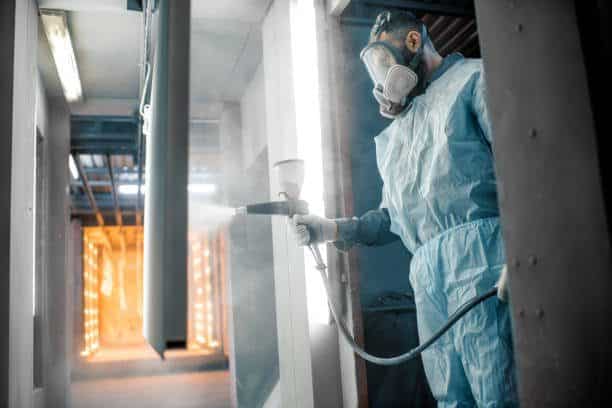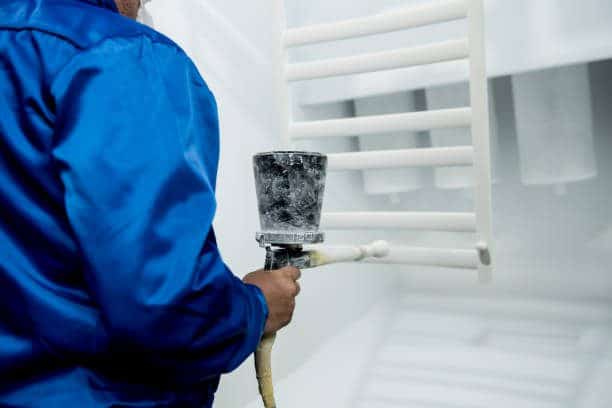Powder Coating Business: A Comprehensive Guide for Success
Introduction
Powder Coating Business. In today’s competitive market, starting a powder coating business can be a lucrative venture. Powder coating is a popular method of applying a durable and attractive finish to various products. Whether you’re a seasoned entrepreneur or a novice looking to explore the industry, this article will provide you with a comprehensive guide to help you establish and run a successful powder coating business. Let’s dive in!
Understanding Powder Coating

What is Powder Coating?
Powder coating is a dry finishing process that involves applying a finely ground powder made of resin, pigment, and other additives to a surface. The powder is electrostatically charged and sprayed onto the object, creating an adhesive coating. It is then cured under heat, resulting in a durable and attractive finish.
Benefits of Powder Coating
Powder coating offers several advantages over traditional wet paint finishes. It provides superior durability, excellent resistance to corrosion, scratches, and fading, and offers a wide range of color options. Powder coating is also environmentally friendly as it produces minimal volatile organic compounds (VOCs) and can be recycled.
Applications of Powder Coating
Powder coating finds applications in various industries, including automotive, architecture, furniture, appliances, and more. It is used to coat metal substrates like steel, aluminum, and iron, offering protection and enhancing the appearance of the finished products.
Setting Up Your Powder Coating Business

Researching the Market
Before starting your powder coating business, conduct thorough market research to identify the demand for your services, potential competitors, and pricing trends. Understanding the market dynamics will help you make informed decisions and develop a competitive edge.
Writing a Business Plan
A well-crafted business plan is essential for any successful venture. It should outline your business goals, target market, pricing strategy, marketing approach, and financial projections. A comprehensive business plan will guide you throughout the setup and operation of your powder coating business.
Securing Funding
Depending on the scale of your business, you may require funding to cover equipment costs, facility leases, marketing expenses, and working capital. Explore financing options such as small business loans, grants, or partnerships with investors to ensure you have the necessary capital to start and sustain your business.
Acquiring Equipment and Facilities
Invest in high-quality powder coating equipment, including spray booths, curing ovens, and powder coating guns. Consider the size and capacity of your equipment based on the scale of operations. Additionally, secure a suitable facility with adequate space, proper ventilation, and necessary utilities to ensure smooth operations.
Legal and Regulatory Considerations

Business Registration and Licensing
Comply with the legal requirements of your jurisdiction by registering your powder coating business and obtaining the necessary licenses and permits. Consult with local authorities or legal professionals to ensure you meet all the regulatory obligations.
Environmental Compliance
Powder coating involves the use of chemicals and may generate hazardous waste. Implement proper waste management practices to safeguard the environment and adhere to environmental regulations. Consider recycling options and dispose of waste responsibly.
Safety and Occupational Health Regulations
Create a safe working environment for your employees by implementing appropriate safety measures. Provide personal protective equipment (PPE), conduct regular safety training, and comply with occupational health regulations to minimize accidents and promote a healthy workplace.
Creating a Strategic Marketing Plan

Identifying Your Target Market
Determine the specific industries, businesses, or consumer segments that are most likely to require powder coating services. Tailor your marketing efforts to reach these target customers effectively. Identify their needs, preferences, and pain points to position your business as a solution provider.
Building an Online Presence
In today’s digital age, having a strong online presence is crucial. Create a professional website that showcases your services, portfolio, and contact information. Utilize social media platforms, online directories, and search engine optimization (SEO) techniques to increase your visibility and attract potential customers.
Also Read: IS A BOUNCE HOUSE BUSINESS A BAD IDEA
Developing a Brand Identity
Build a strong and recognizable brand identity that differentiates your powder coating business from competitors. Design a logo, choose a color palette, and develop consistent branding elements across all marketing materials. A cohesive brand identity will help establish trust and make your business memorable.
Implementing Effective Marketing Strategies
Deploy a mix of marketing strategies to promote your powder coating business. Consider online advertising, content marketing, email marketing, and attending industry trade shows or local events. Collaborate with complementary businesses or offer referral programs to expand your customer base.
Operating Your Powder Coating Business
Workflow and Production Processes
Establish efficient workflow processes to ensure smooth operations and timely order fulfillment. Plan the sequence of tasks, implement quality control measures, and monitor production schedules to meet customer expectations. Streamline processes to maximize productivity and minimize bottlenecks.
Quality Control and Assurance
Deliver exceptional quality by implementing rigorous quality control and assurance measures. Inspect incoming materials, monitor the coating process, and conduct final inspections before delivery. Consistently meeting or exceeding customer expectations will help build a strong reputation for your business.
Managing Inventory and Supplies
Maintain an organized inventory management system to track raw materials, consumables, and finished products. Optimize inventory levels to avoid stockouts or excessive carrying costs. Establish relationships with reliable suppliers to ensure a steady supply of high-quality materials.
Building Strong Customer Relationships
Invest in building strong relationships with your customers. Communicate clearly, provide accurate quotes, and deliver on time. Offer exceptional customer service, address customer concerns promptly, and go the extra mile to exceed their expectations. Positive word-of-mouth referrals can significantly impact your business growth.
Providing Exceptional Customer Service
Understanding Customer Needs
Take the time to understand your customer’s unique requirements. Listen actively, ask questions, and offer tailored solutions. By understanding their needs, you can provide a personalized experience that sets you apart from the competition.
Clear Communication and Responsiveness
Maintain clear and open lines of communication with your customers. Respond promptly to inquiries, provide progress updates, and address any concerns or issues they may have. Establishing good communication fosters trust and loyalty.
Timely Order Fulfillment
Strive for timely order fulfillment to meet customer deadlines. Implement efficient order processing and production scheduling systems to minimize delays. Communicate any potential delays proactively and offer alternative solutions whenever possible.
Handling Customer Complaints
Even with the best intentions, issues may arise. When faced with customer complaints, address them promptly and professionally. Listen attentively, apologize for any inconvenience caused, and offer a fair resolution. Turning a dissatisfied customer into a happy one can lead to long-term loyalty.
Scaling and Growing Your Business
Expanding Your Service Offerings
As your powder coating business establishes a strong foundation, consider expanding your service offerings. Explore additional finishing options, such as specialty coatings or custom color matching. Catering to a broader range of customer needs can attract new clients and increase revenue.
Investing in Advanced Equipment
To enhance your productivity and maintain a competitive edge, invest in advanced powder coating equipment. Stay updated with industry advancements and consider automation or new technologies that can streamline processes and improve efficiency.
Hiring and Training Employees
As your business grows, you may need to hire additional staff. Look for individuals with experience in powder coating or provide training opportunities to develop their skills. A knowledgeable and skilled team will contribute to the overall success of your business.
Exploring New Market Opportunities
Identify emerging market trends and explore new opportunities within the powder coating industry. Stay informed about new applications or industries that could benefit from your services. Adapting to changing market demands will help you stay ahead of the competition.
Ensuring Sustainability and Profitability
Efficient Energy Usage
Implement energy-efficient practices to reduce costs and minimize your environmental impact. Optimize oven curing cycles, use energy-efficient lighting, and invest in equipment with low energy consumption. Not only will this benefit the environment, but it will also contribute to long-term cost savings.
Waste Management and Recycling
Develop a waste management strategy to handle powder coating overspray and other waste materials. Explore recycling options for powder overspray or partner with recycling facilities. Implement proper disposal methods for hazardous materials to comply with regulations.
Continuous Process Improvement
Regularly assess your operational processes to identify areas for improvement. Encourage feedback from employees and customers to gain insights into potential enhancements. Continuously refine your processes to enhance productivity, quality, and customer satisfaction.
Financial Monitoring and Analysis
Monitor your financial performance closely by tracking revenue, expenses, and profitability. Use accounting software or hire a professional accountant to maintain accurate records. Analyze financial data to identify trends, assess the effectiveness of marketing efforts, and make informed business decisions.
Conclusion
Starting and running a successful powder coating business requires careful planning, attention to detail, and a commitment to providing exceptional service. By following this comprehensive guide, you’ll be well-equipped to navigate the industry, satisfy customer demands, and achieve long-term profitability. Embrace the opportunities, adapt to changes, and continuously strive for excellence in all aspects of your business.
FAQs
Q1: What is the cost of starting a powder coating business?
The cost of starting a powder coating business can vary depending on factors such as the scale of operations, equipment selection, facility lease, and marketing expenses. It is recommended to create a detailed business plan and consult with industry experts to estimate the startup costs accurately.
Q2: Can I powder coat any material?
Powder coating is primarily used on metal substrates such as steel, aluminum, and iron. However, advancements in powder coating technology have enabled the coating of other materials like plastic and wood. Consult with powder coating suppliers and manufacturers for guidance on coating-specific materials.
Q3: How long does powder coating last?
Properly applied and maintained, powder coating can last for many years. The durability of the finish depends on factors such as the quality of the coating, substrate preparation, and environmental conditions. Powder coating generally offers superior resistance to corrosion, fading, and scratches compared to traditional wet paint.
Q4: Can I apply powder coating myself?
While it is possible to apply powder coating yourself, it requires specialized equipment and expertise. Investing in professional-grade equipment and understanding the powder coating process is crucial to achieving optimal results. Consider partnering with an experienced powder coating service provider for high-quality and consistent finishes.
Q5: Is powder coating environmentally friendly?
Yes, powder coating is considered environmentally friendly. It produces minimal volatile organic compounds (VOCs) and does not require solvents. Additionally, powder coating overspray can be collected and reused, minimizing waste. Be sure to follow proper waste management practices and adhere to environmental regulations to maintain sustainability.

